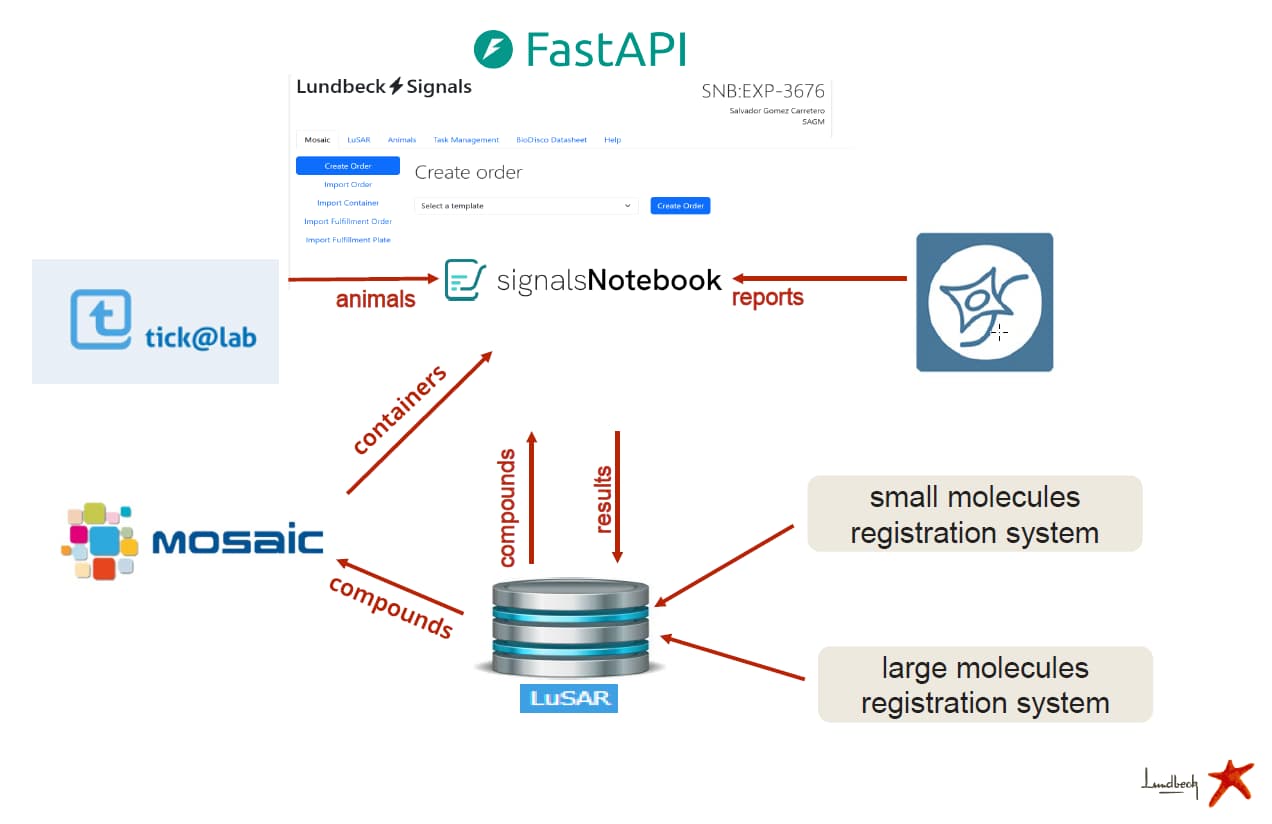Introduction
H. Lundbeck A/S is a science-driven, mid-sized pharmaceutical company with headquarters in Denmark. Specializing in neuroscience, with a commitment to R&D, they developed and launched one of the world’s first antipsychotics in 1959.
In 2023, Lundbeck recognized that it needed a new data management system to support the company’s cross-disciplinary research. Its legacy electronic laboratory notebook (ELN) system was becoming unsustainable for its 170 biologists—as it had effectively become a “file dump,” unsearchable and inefficient—because of both technology limitations and poor implementation. Nevertheless, many users were reluctant to try a new system, skeptical that it would address their needs, particularly for biology research. The Lundbeck research informatics group had to solve this problem quickly, and with a small team.
After evaluating different solutions, Lundbeck decided on Signals Notebook from Revvity Signals Software. As its subject matter experts (SMEs) explored the potential for what this modern ELN could do, the project evolved conceptually from a centralized place for documentation into a true solution for collaboration and scientific data workflows.
Supporting Biology R&D
Lundbeck was already familiar with Signals Notebook, as its chemists were impressed with it after using it for five years without much customization—documenting reactions, attaching documents with testing results, and registering compounds. However, Lundbeck’s biologists had different requirements for data capture and workflow, and were not using Signals Notebook. They instead had been using an outdated ELN essentially as a repository for files, but without proper organization or governance. The system lacked searchability or structured data, and common rules or terms for data entry, leading to inconsistencies and data management issues.
Adding to the challenge, management was only able to dedicate limited resources to implementing a new ELN for its biologists, assigning three full-time developers of the research informatics team to fulfill project requirements—and just a year for implementation.
Meeting the Challenges
The implementation team drilled down on what type of sustainable system it could deliver, given its limited resources and time, homing in on a minimum viable product.
After assessing the “data dump” problem with their old system, the team concluded that the issue was not just the technology; it was also a result of the biologists’ poor use of the system. This meant the first step to making the most of a new ELN would be to develop rules, governance, and common scientific terms.
Scientists from different departments worked to define requirements and establish a unified list of common terminologies and ontologies. They built a Python-based system using FastAPI and SQLAchemy to automatically create API endpoints for their list of terms, creating an external attribute list. Each list—be it brain regions, vehicles, or tissue types—represented its own “view” in the database that was turned into a set of API endpoints Signals Notebook could draw from. This enabled dynamic creation of external attribute lists in Signals Notebook that connect directly to external data sources.

The next priority was to improve search, and be able to track the flow of information across experiments. For IP management reasons, the biologists had been instructed to drop their experiment files into the old ELN, but because it was impossible to search efficiently, they had to write down where they had saved their experiments; otherwise the files could not be found afterward. In its Signals Notebook rollout, Lundbeck heavily leveraged automation for collaboration and tracking, by creating tasks and associated data sheets within the platform. To avoid importing all the data from the old system, they integrated the various source-of-truth registration systems, creating shallow proxy materials in Signals Notebook that contained core properties and links to full material records. Automated systems were built to synchronize compound data from corporate databases to Signals Notebook.
Fitting the System for Purpose
As Lundbeck implemented Signals Notebook, it saw an opportunity to incorporate functionalities normally seen in a laboratory information management system (LIMS). Users wanted a single place where they could do everything—communicate, track tasks, and transfer information from one experiment to another. They developed a FastAPI-based web portal to provide LIMS functionalities and interact with external systems from Signals Notebook.
Integrating LIMS functionalities also incentivized users to adopt structured data entry, as it meant they spent less time on copy-pasting and data import, freeing up time for more substantive work. This benefit helped overcome an ingrained cultural mindset toward individual data ownership, encouraging scientists to make “their” data available to everybody.
Some users were also reluctant to adopt a new system, preferring their existing workflows— particularly Excel. To address that user preference, Lundbeck developed external tools to download and upload data via Excel, with controlled drop-downs for data validation. With this pragmatic approach, users can retain the Excel functionalities they are accustomed to—such as moving cells around— while maintaining metadata standards and data stewardship. This solution was facilitated by the flexibility of Signals Notebook, which enables integrations and extensions to external software and systems.
Lundbeck also found that Signals Notebook could fill in gaps in the organization’s assay registration system, which is highly structured but lacks granularity. In some cases, scientists had struggled to feed in their experiments or assays, but Signals simplified the process of assay registration. There was also concern that theoretical modelers would not be able to use Lundbeck’s data in the future. Signals allowed Lundbeck to move its data to the cloud-based warehouse Snowflake for future data mining and AI applications.
Quote from Salvador Gomez-Carretero
“Definitely implementing Signals Notebook has improved the way we do things—a lot.”
A Collaborative Solution to Advance Chemical and Biological Research
Signals Notebook provided the Lundbeck team with a true solution for collaboration and scientific data workflows—one that addressed the needs of both chemists and biologists. In particular, Lundbeck has identified eight notable benefits from the implementation of Signals Notebook:
- Data is now well structured, searchable, and accessible.
- IP is better protected, as data is stored securely and managed effectively.
- With improved searchability, researchers avoid unnecessary repetition of experiments,
- Theoretical models have better data to work with, because all data is now connected.
- Analytical departments are more productive, through dashboards that allow them to organize and optimize their workflows.
- Overall, scientists use their time more effectively and more efficiently.
The benefits of the solution are evidenced by the high level of user adoption. Within just two weeks of rollout, Lundbeck needed to order 30 more user licenses. Even reluctant departments are getting on board, as they see the benefits other groups are gaining from the platform.
Quote from Salvador Gomez-Carretero
“You can really see that the concept and the need for a structured data is really starting to get through, even to our more reluctant users.”
Additional Key Takeaways
Through its experience implementing Signals Notebook, the Lundbeck team found several strategies that facilitated the process:
- Stakeholder management: Engaging stakeholders, especially line managers, was crucial for successful implementation.
- Strategic department adoption: Starting with departments that can provide leverage helped drive wider adoption. Analytical departments, such as PK/PD, appreciate a structured approach and will encourage others to use a platform like Signals Notebook that enables structured data sharing.
- Super-user model viability: Super-users in each department were crucial for template maintenance, given the company’s size and limited project resources.
- Middle-ground approach: A pragmatic, middle-ground approach that reused existing systems and focused on core needs proved to be effective.
A Modern Data Management System, for Today and the Future
Lundbeck's implementation of Signals Notebook demonstrates a practical approach to modernizing the scientific data workflow at a mid-sized pharmaceutical company. This new solution saw higher adoption rates compared to the legacy ELN, thanks to features that addressed all scientists’ specific needs, particularly those of the biologists; collaboration in setting up templates suitable for all departments, and the right incentives. By engaging stakeholders and leveraging existing systems, they successfully overcame the limitations of their legacy ELN to streamline scientific workflows and enable collaboration—while laying the groundwork for expansion to additional sites and positioning the data for an AI future.
View more case studies at Revvity Signals.

End-to-end workflow support across scientific disciplines.

The Standard for Chemical Drawing.

End-to-end Clinical Data Science Platform.

